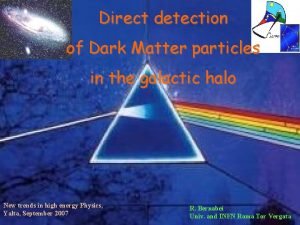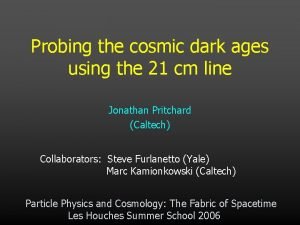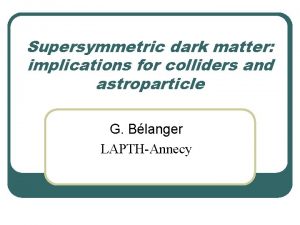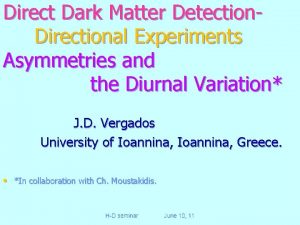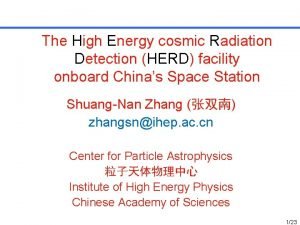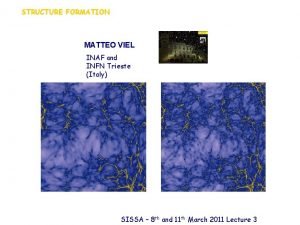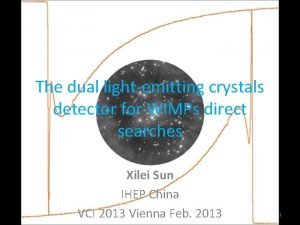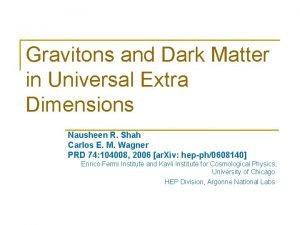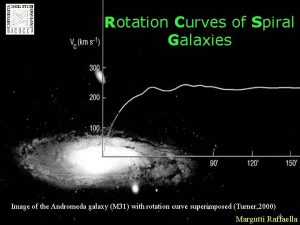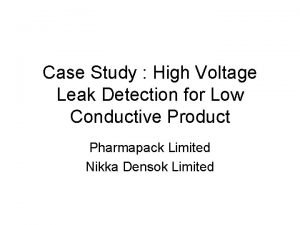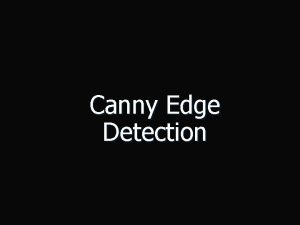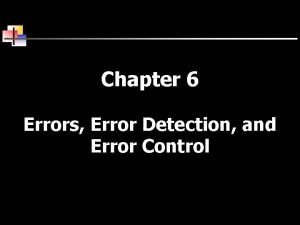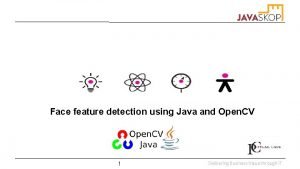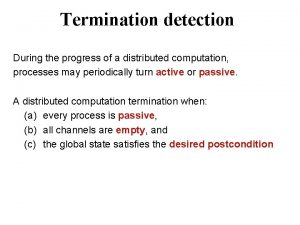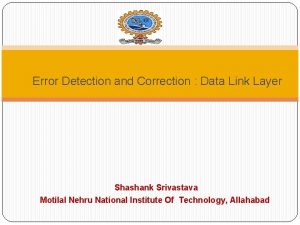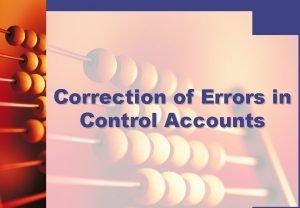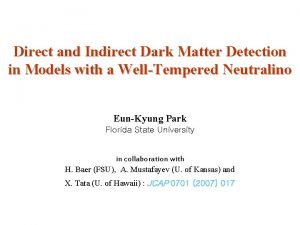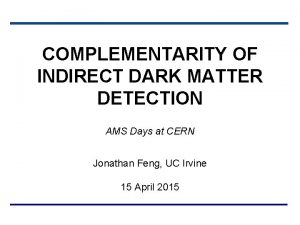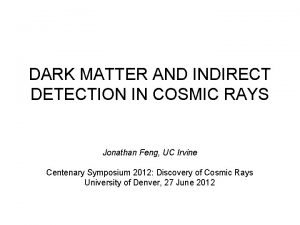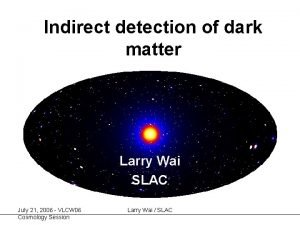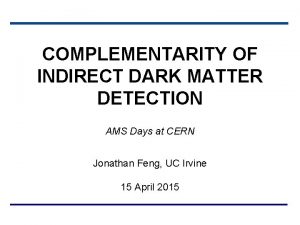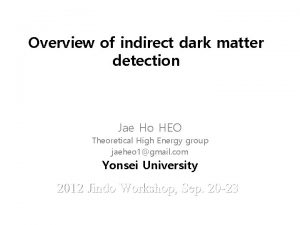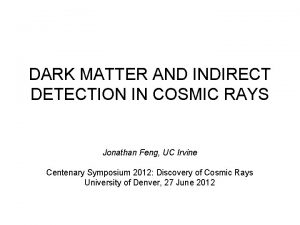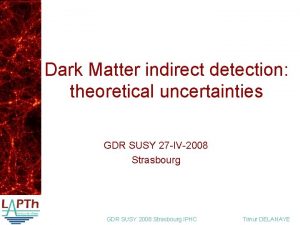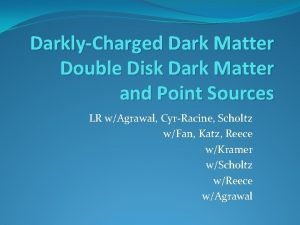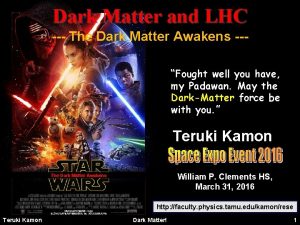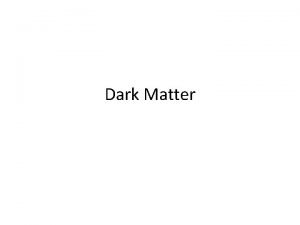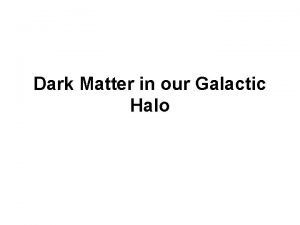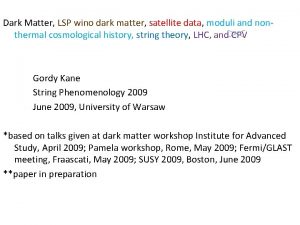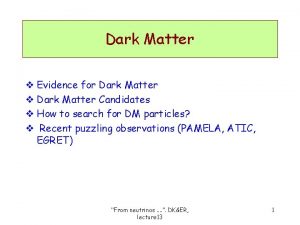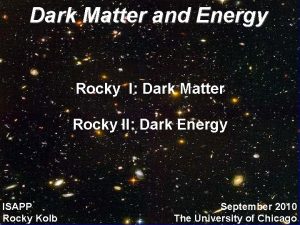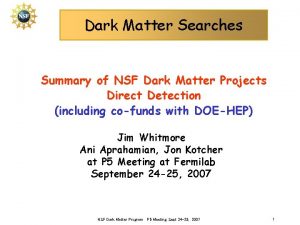Indirect detection of Dark Matter from an experimental




































- Slides: 36

Indirect detection of Dark Matter …. from an experimental point of view …. Jan Conrad conrad. at. fysik. su. se A Decade of New Experiments XXXVII SLAC Summer Institute, August 3 -14, 2009.

The reason why I am not at SLAC Ellen, 14 month 09 -02 -02 / Me Thanks for suggesting this solution to Greg Madejski and Jo. Anne Hewett (we’ll see if it works).

• Questions can be adressed to me by mail: conrad@physto. se (there are no stupid questions!) • During lectures I usually try to read the audience, which will not be possible positive and negative feedback would be very useful (via mail). 09 -08 -07 Jan Conrad, Stockholm Universitet 3

Goal for the lectures. • You should understand the experimental approaches to indirect detection of dark matter and what we can expect in the next decade. • You should understand that DM indirect detection is challenging and what the challenges are • I hope I can give you some additional insight in what to make of the presented results. • I hope I will be able to convey the message that revolutions are on the horizon. 09 -08 -07 Jan Conrad, Stockholm Universitet 4

Contents and non-contents • Not in this lecture(s): – Why DM ? Tegmark, Weiner – DM candidates Weiner – Results will be presented mainly if they illustrate a special point for newest results: see talks by Moskalenko, Pearce, Burnett, Egberts • Lecture I – Preliminaries (minimal theoretical background) – The set up – Charged cosmic rays, • Signatures • Astrophysics and backgrounds Also important for – A detour cosmic ray diffusion in the Galaxy gamma-rays --– Instrumental background lecture II • Experimental approaches • PAMELA, ATIC, FERMI results on charged cosmic rays. • GAPS 09 -08 -07 Jan Conrad, Stockholm Universitet 5

• Lecture II – Gamma-rays • Signatures • Astrophysics and backgrounds • Experimental approach and experiments • Source confusion • Selected Results – Neutrinos • Signature • backgrounds • Experimental approach and experiments • Selected results • Impact of Astrophysics – Interplay between different indirect experiments – Indirect indirect detection (multi-wavelength) Some additional slides contain more detailed information … 09 -08 -07 Jan Conrad, Stockholm Universitet 6

The set-up • Prime DM candidate: Weakly Interacting Massive Particle (WIMP), denoted by c • Mass: ~ 10 Ge. V - ~ 10 Te. V • ”Weakly” interacting • Experimental signatures (roughly) applicable to a variety of candidates: – – Supersymmetric neutralino Kaluza Klein Axino, Gravitino, Super. WIMPs …. etc. • Other CDM candidates: – axions ( discussed if time) For motivation and theory: see Neil Weiners talk 09 -08 -07 Jan Conrad, Stockholm Universitet 7

The set-up: WIMP annihilation or decay c c W-/Z/q p 0 W+/Z p /q nm m n mn e e± Anti-p, anti-d Indirect detection rate = (particle physics part) × (astrophysical part) PPP 09 -08 -07 Jan Conrad, Stockholm Universitet APP 8

Signal: general considerations • Particle physics part orders of magnitude parameter space (x-sections) – DM particle’s spin mass, annihilation cross section, branching fraction into final states and yield for a given final state (given by underlying theory (KK, MSSM, IDM etc). For experimentalist: Analysis optimized for given signature > Order of magnitude uncertainties • Astrophysical part – (Density of DM particles)2, diffusion, absorption (where applicable) For experimentalists: Where to look for the signal? More details in respective section. Note there is virtually no experiment dedicated solely (or even mainly) to IDMD !!! (one Jan Conrad, Stockholm Universitet 09 -08 -07 exception: GAPS …. will be discussed. ) 9

Dark Matter on Galactic scales Cosmic rays c e+- W /Z/q _ W+/Z /q ec 09 -08 -07 p m e± Anti-p, anti- d Jan Conrad, Stockholm Universitet 10

Cosmic rays: signatures Positron fraction and spectrum Antiproton fraction and 09 -08 -07 spectrum Jan Conrad, Stockholm Universitet Anti-deuteron spectrum 11

APP: cosmic ray propagation in the Galaxy: why we need to talk about it: • Cosmic rays produced in secondary processes provide a formidable background to DM searches with anti-particles. • Photon-production by Galactic cosmic rays provide a formidable background to DM searches with gamma-rays • Any potential signal in CR will need to be interpreted with effects of the propagation in mind Strong et al, Ap. J 537, 736, 2000 Diffuse gamma-ray Jan Conrad, Stockholm Universitet 09 -08 -07 prediction 1 Strong et al, Ap. J 613, 962, 2004 Diffuse gamma-ray 12 prediction 2

APP: cosmic ray propagatioin in the galaxy To some: To us: Diffusion reacceleration decay Radiation field s nc sy energy loss spallation IC h convection em B-field CNO br B-field Gas e p DM 09 -08 -07 π0 γγ π± e± Gas p-bar, Jan Conrad, Stockholm Universitet π± e± π0 γγ Li, B 13

Many other experiments will be important for indirect detection: • By standard, quantitatively described by diffusion equation (see additional slides) with a number of assumptions (e. g. GALPROP code) • Constrained through CR and gamma-ray observations • Diffusion coefficient Primary/secondary nuclei ratio (HEAO 3, ACE, PAMELA, CREAM, TRACER) • Interstellar radiation field: optical, FIR, CMB (DIRBE, FIRAS) • Interstellar gas (H 1, HII) 21 cm, CO surveys (Bonn, Parkes) • B-field radio surveys (Jodrell Bank, Parkes , WMAP, Planck) • Spallation, pion production cross-sections accelerators For a more detailed account: Moskalenko, Jan Conrad, Stockholm Universitet 09 -08 -07 SSI 2008 14

Cosmic ray anti-matter: detection principle Scintillator (TOF) PID (TRD, Cherenkov) magnet Anticoincidence (scintillator) Scintillator (TOF) PID (TRD, Cherenkov) Calorimeter 09 -08 -07 Jan Conrad, Stockholm Universitet 15

1. 2 m, 450 kg 1. 5 m, ~6000 kg Examples: PAMELA and AMS-02, spectrometer 09 -08 -07 Jan Conrad, Stockholm Universitet 16

Examples for ”calorimeters”: ATIC/FERMI/HESS e e– + 1500 kg, h=1. 2 m 09 -08 -07 Jan Conrad, Stockholm Universitet 17

Example: PAMELA and ATIC • Launched: June 15, 2006 from Baikonur, • Three flights (2001, 2003 and 2008) • Quasi-polar orbit • Total livetime: 50 days • Expected livetime: > 3 years 09 -08 -07 Jan Conrad, Stockholm Universitet 18

Instrumental backgrounds for e+, e-, γ Hadronic background is dominant. Necessary rejection factors: ATIC, Fermi electrons ~ 103 -4 PAMELA, AMS ~ 104 -5 Fermi γ ~ 105 -6 09 -08 -07 Jan Conrad, Stockholm Universitet 19

Hadron/electron discrimination • Main idea: – Veto detectors (Anticoincidence) – difference in shower shape for em/hadronic showers in calorimeter – Background rejection gets harder with rising energy – Full analyses apply combined information of several detectors in multivariate classification (Neural networks …) 09 -08 -07 Jan Conrad, Stockholm Universitet 20

Example: Fermi electron analysis. 09 -08 -07 Jan Conrad, Stockholm Universitet 21

Anti-proton/proton ratio 500 days of data, 109 triggers, ca. 1000 anti-protons, ca. 107 protons, background < 3 % 6 anti-protons ca 600 > 5 Ge. V O. Adriani et al. Phys. Rev. Lett. 102: 051101, 2009 09 -08 -07 Jan Conrad, Stockholm Universitet Compatible with secondary production 22

Positron fraction: the PAMELA anomaly 500 days of data, 150 k electrons, 10 k positrons Errors include background removal uncertainty Very soft electron spectrum (index: 3. 54) at odds with Fermi (see later) Conventional production: Delahaye et. al ar. Xiv: 0809. 5268 Conventional production: GALPROP O. Adriani et al. Nature 458: 607 -609, 2009 09 -08 -07 Jan Conrad, Stockholm Universitet Strong & Moskalenko Astrophys. J. 509: 212228, 1998 23

Possible sources • No extra source: – Experimental M. Schubnell, ar. Xiv: 0905. 044 – Non standard diffusion • Extra source B. Katz et al. , ar. Xiv: 0907. 1686 – Dark matter – Conventional sources • Pulsars • Supernovae 09 -08 -07 Jan Conrad, Stockholm Universitet P. Biermann et al. , ar. Xiv: 0903. 4048 L. Bergström et al. , Phys. Rev. D 78: 103520, 2008 D. Malyshev et al. 0903. 1310 24

Pulsars invoked already 20 years ago …. 09 -08 -07 Jan Conrad, Stockholm Universitet 25

e++e- spectrum: the ATIC anomaly Based on ATIC 1 + ATIC 2 ATIC collab. Nature 456, 362 -365(2008) Statistical errors only, background subtracted HEAT BETS PPBBETS x Emulsion chambers background GALPROP Sol. Mod. 09 -08 -07 Jan Conrad, Stockholm Universitet 26

Fermi-LAT as an electron detector IC AT d un o r g ack b Fermi-LAT effective geometric Factor Energy resolution: ~ 20 %@ 1 Te. V (cf. ATIC ~ 2 % @ 150 Ge. V cf. PAMELA ~ 6 % @ 200 Ge. V ) 09 -08 -07 Residual hadron Cf: ATIC effective geometric factor contamination Jan Conrad, Stockholm Universitet (less for PAMELA) < 20 % 27

e++e- spectrum A. Abdo (Fermi-LAT) Phys. Rev. Lett. 102: 181101, 2009 6 month of data • ATIC is gone? ? • Data is compatible with power-law (3. 04). • Is there a deviation from power-law? 3. 8 σ 5. 1 σ , Isbert (ATIC, TANGO in Paris 2009) One slide on possible explanations in appendix Also see Eun-Suk Seo’s topical talk ATIC: F. Aharonian (HESS), ar. Xiv: 0905. 0105 ± 09 -08 -07 15 % Jan Conrad, Stockholm Universitet reject KK model that fits ATIC at 99% (including E resolution). 1724 events > 100 Ge. V Fermi: 171431 events> 100 Ge. V 28

…and explanations …. • No extra source: – Experimental (for ATIC) – Non standard diffusion D. Grasso et al. , ar. Xiv: 0907. 0373 • Extra source – Dark matter – Conventional sources • Pulsars • Supernovae P. Biermann et al. , ar. Xiv: 0903. 4048 09 -08 -07 Jan Conrad, Stockholm Universitet Bergström et al. 0905. 0333 29

A remark on boost-factors • The annihilation cross-section is set by DM abundance in Big bang freeze out not sufficient to explain observed alleged signal. • ”Boost” of rate has been invoked: 09 -08 -07 DM substructure e. g. Sommerfeld factor ~ 10? ? ~ 0 -1000? (requires modifications to model) Jan Conrad, Stockholm Universitet L. Bergström, ar. Xiv 0903. 4849 30

If it is DM, what would it mean? • Data prefers models with mostly leptonic annihilation channels (in fact, muons) • Most models predict rather large masses (> 1 Te. V). • This is hard to accomodate within MSSM considering the anti-proton (gamma) constraint. • Most models need an additional enhancement of annihilation cross-section (”boost”). • Most models make predictions which are testable with soon existing data (gamma-rays). One can ask how much sense it makes to do this considerations at this point of time …. . some groups even publish theoretical analysis on preliminary data …. which I think is not very useful (unless you go with Carlo Rubbia (alleged): ”Better wrong than late” ) 09 -08 -07 Jan Conrad, Stockholm Universitet 31

Cosmic ray detectors of relevance to DM TRACER AMS PEBS VERITAS Fermi PAMELA HESS future exp. spectrometers ”calorimeters” auxiliary 09 -08 -07 BESS-polar Jan Conrad, Stockholm Universitet PPB-Bets ATIC CREAM GAPS CALET 32

Cosmic ray experiments: comparison 09 -08 -07 Jan Conrad, Stockholm Universitet 33

GAPS detection principle _ p* D Slide stolen from Jason Koglin, Columbia U. Plastic Scintillator TOF Si(Li) Target/Detector p* Atomic Transitions Auger e- no, lo Refilling en=n. K~15 44 ke. V n=6 g n=5 g n=4 g n=3 Ladder Deexcitations Dn=1, Dl=1 n=2 30 ke. V p* p* A time of flight (TOF) system tags candidate events and records velocity The antiparticle slows down & stops in a target material, forming an excited exotic atom with near unity probability Deexcitation X-rays provide signature 09 -08 -07 Jan Conrad, Stockholm Universitet p+ n=1 p+ ppo p- Nuclear Annihilation Pions from annihilation provide added background suppression 34

GAPS sensitivity 2011 prototype 2014 flight GAPS white paper 09 -08 -07 Jan Conrad, Stockholm Universitet 35

Summary (cosmic rays): • General: – CR probe DM on Galactic scales – Cosmic ray propagation in the Galaxy is important for gamma-rays and cosmic rays needs imput from a variety of experiments. – Instrumental and astrophysical backgrounds are challenging. – Anti-deuterons provide a potential smoking gun signal • Status: – PAMELA let the genie out of the bottle – Signatures detected which could be the first sign of DM. – The experimental situation is confusing with different (apparently) not consistent results (ATIC vs. Fermi !, PAMELA vs. Fermi ? ). • Outlook: – Future experiments (AMS-02, PEBS) and additional data will be crucial: • For constraining backgrounds for e. g. gamma-rays and cosmic rays. • For distinguishing signal hypothesis. 09 -08 -07 Jan Conrad, Stockholm Universitet 36
 Dark matter and dark energy presentation
Dark matter and dark energy presentation Experimental vs non experimental
Experimental vs non experimental Descriptive studies
Descriptive studies Experimental vs non experimental research
Experimental vs non experimental research Experimental vs nonexperimental research
Experimental vs nonexperimental research Experimental vs non experimental
Experimental vs non experimental In a dark dark town
In a dark dark town Where to stream dark matter
Where to stream dark matter Les houches dark matter
Les houches dark matter Dark matter
Dark matter What could dark matter be
What could dark matter be Calo
Calo Matteo viel
Matteo viel Cindms
Cindms Dark matter just gravitons dimensions
Dark matter just gravitons dimensions Dark matter physics
Dark matter physics Dark matter
Dark matter Boosted dark matter
Boosted dark matter Gray matter and white matter
Gray matter and white matter Chapter 2 section 1 classifying matter answer key
Chapter 2 section 1 classifying matter answer key Pallium telencephalon
Pallium telencephalon Section 1 composition of matter
Section 1 composition of matter What makes up the diencephalon
What makes up the diencephalon Flow energy review
Flow energy review Grey vs white matter
Grey vs white matter Section 1 composition of matter chapter 15 answer key
Section 1 composition of matter chapter 15 answer key Section 1 composition of matter
Section 1 composition of matter The providential detection
The providential detection High voltage leak detection
High voltage leak detection Face detection viola jones
Face detection viola jones Leading edge detection
Leading edge detection Perceptual expectancy
Perceptual expectancy Error detection methods
Error detection methods Java face detection
Java face detection Dijkstra scholten algorithm
Dijkstra scholten algorithm Error detection and correction in data link layer
Error detection and correction in data link layer Errors not revealed by control accounts
Errors not revealed by control accounts







